Lots of people know the state of Alabama is the United States’ peanut capital, home to the delicious shrimp and grits dish that so many are crazy about, and the residence of the U.S. Space and Rocket Center. But if you’re more into birdwatching than legumes, crustaceans, and space, you’ll be happy to know that there are 420 bird species you can see and study in Alabama.
There are currently 158 species that regularly breed in Alabama and can be seen in its 21 state parks, 8 national parks, and 4 forests. Moreover, 174 species regularly spend their winters there, and about 80 species migrate through the state on their way to warmer temperatures.
This list highlights the most famous birds you’re likely to spot if you’re an Alabama resident or currently spending time in the Cotton State. Keep on reading to learn more about them!
Red Birds in Alabama
Northern Flicker

- Scientific Name: Colaptes auratus
- Length: 11-14 inches
- Weight: 3-5.9 ounces
- Wingspan: 17-21 inches
The common flicker, or the northern flicker, is larger than other woodpeckers and has a brownish beige body with black marks covering the wings and back. The yellow-shafted northern flicker can be found all-year-round in Alabama.
Unlike other woodpeckers, this one is a ground feeder, usually sticking its long tongue into ant colonies. It also feeds on horizontal branches, protecting the crops from various pests.
You’ll be able to see these types of birds near residential areas, as they like to bang on man-made objects to mark their territory.
House Finch

- Scientific Name: Haemorhous mexicanus
- Length: 5-6 inches
- Weight: 0.6-0.9 ounces
- Wingspan: 8-10 inches
Although females of this species of birds usually have pale brownish-gray plumage, male house finches have rosy red faces and upper chests that make them easy to spot. However, the brightness of the red feathers depends on the bird’s diet.
A house finch can be seen around bird feeders or slowly walking on the ground trying to crush the seeds. A twittering song announces the presence of a noisy group of House Finches, especially if you keep a fresh supply of black oil sunflower seeds out in backyard bird feeders.
Downy Woodpecker

- Scientific Name: Dryobates pubescens
- Length: 5.5-7.1 inches
- Weight: 0.7-1 ounce
- Wingspan: 9.8-12.2 inches
The downy woodpecker has a black body with a white back and belly. It also has a checkered head and is one of the smallest woodpeckers you can find in Alabama.
Males and females can be told apart by the red patch that grows on the back of the head of males. Downy woodpeckers are common feeder birds, especially when food is scarce.
Red-Bellied Woodpecker

- Scientific Name: Melanerpes carolinus
- Length: 9-10.5 inches
- Weight: 2-3.2 ounces
- Wingspan: 15-18 inches
The Red-Bellied Woodpecker is easy to spot in Alabama, thanks to its distinctive barred back and bright red cap. It spends most of its time sticking its barbed-tip tongue into the crevices of dead trees looking for larvae.
It likes to hide nuts for later use and might visit your backyard in the winter to look for food like insects, acorns, or even small fish if there’s a pond on your property.
Red-Headed Woodpecker

- Scientific Name: Melanerpes erythrocephalus
- Length: 7.5-9.8 inches
- Weight: 2-3.4 ounces
- Wingspan: about 16.7 inches
These medium-sized birds have black backs, white bellies, and easy-to-spot red heads, although young birds’ heads are gray before turning a bright crimson color when they mature.
Unlike other woodpeckers, the red-headed woodpecker will catch insects while they’re flying. It feeds on seeds, nuts, berries, small rodents, and even young birds.
Red-Tailed Hawk

- Scientific Name: Buteo jamaicensis
- Length: 17.7-25.6 inches
- Weight: 24.3-51.5 ounces
- Wingspan: 44.9-52.4 inches
Thanks to its appearance, which includes a brown body and yellow and cinnamon-colored tail, the red-tailed hawk is easy to spot. These hawks are skilled birds of prey who keep their eyes on the prize — small mammals, birds, and reptiles — before quickly diving to catch it.
Its most distinct feature, however, is its famous loud scream that can be heard as it sits perched on fence posts. If you’ve ever watched a movie or television show that had an eagle or hawk on-screen, the sound used was likely the cry of our feathered friend with the red tail.
Blue Birds in Alabama
Blue Jay

- Scientific Name: Cyanocitta cristata
- Length: 9-12 inches
- Weight: 2.5-3.5 ounces
- Wingspan: 13-17 inches
The color of a blue jay’s plumage ranges from lavender to medium-blue in the crest, back, wings, and tail, and it has a white face. The blue plumage isn’t actually the result of pigments but is instead related to the light interference that reflects off the structure of the feathers.
The blue jay’s love for acorns helps spread oak trees around its habitat. The bird can be seen in your backyard if you fill a feeder with peanuts, sunflower seeds, and suet.
To warn other members of the family of impending danger, the blue jay might let out its noisy call, a sound that mimics the call of hawks.
Blue-Throated Mountain-Gem

- Scientific Name: Lampornis clemenciae
- Length: 4.5-4.9 inches
- Weight: about 0.3 ounces
- Wingspan: 2.7-3 inches
When comparing this species to other hummingbirds, the blue-throated mountain-gem is a little larger, and it has a full tail and extended wings. A male blue-throated mountain-gem is a bronzy green color with white lines below his eyes and has a white-tipped black tail, but what makes it easy to spot is its spot of bright blue feathers that females of this species lack.
Also known as the blue-throated hummingbird, this bird usually follows smaller hummingbirds to feed on the nectar from flowers or hummingbird feeders. During the dry season, however, this hummingbird will feed on small insects and spiders.
Blue-Winged Teal

- Scientific Name: Spatula discors
- Length: about 16 inches
- Weight: about 13 ounces
- Wingspan: about 23 inches
The blue-winged teal can be found in Alabama during summer and fall, as it makes a stop in the state during its migration trip. Most of the bird’s body is buffy colored, and the male has a gray-blue head with a black bill.
This bird lives around the edges of ponds, where it looks for a concealed spot to rest. You’ll find this small duck feeding on aquatic insects, clams, snails, as well as vegetation, and grains.
Blue-Headed Vireo
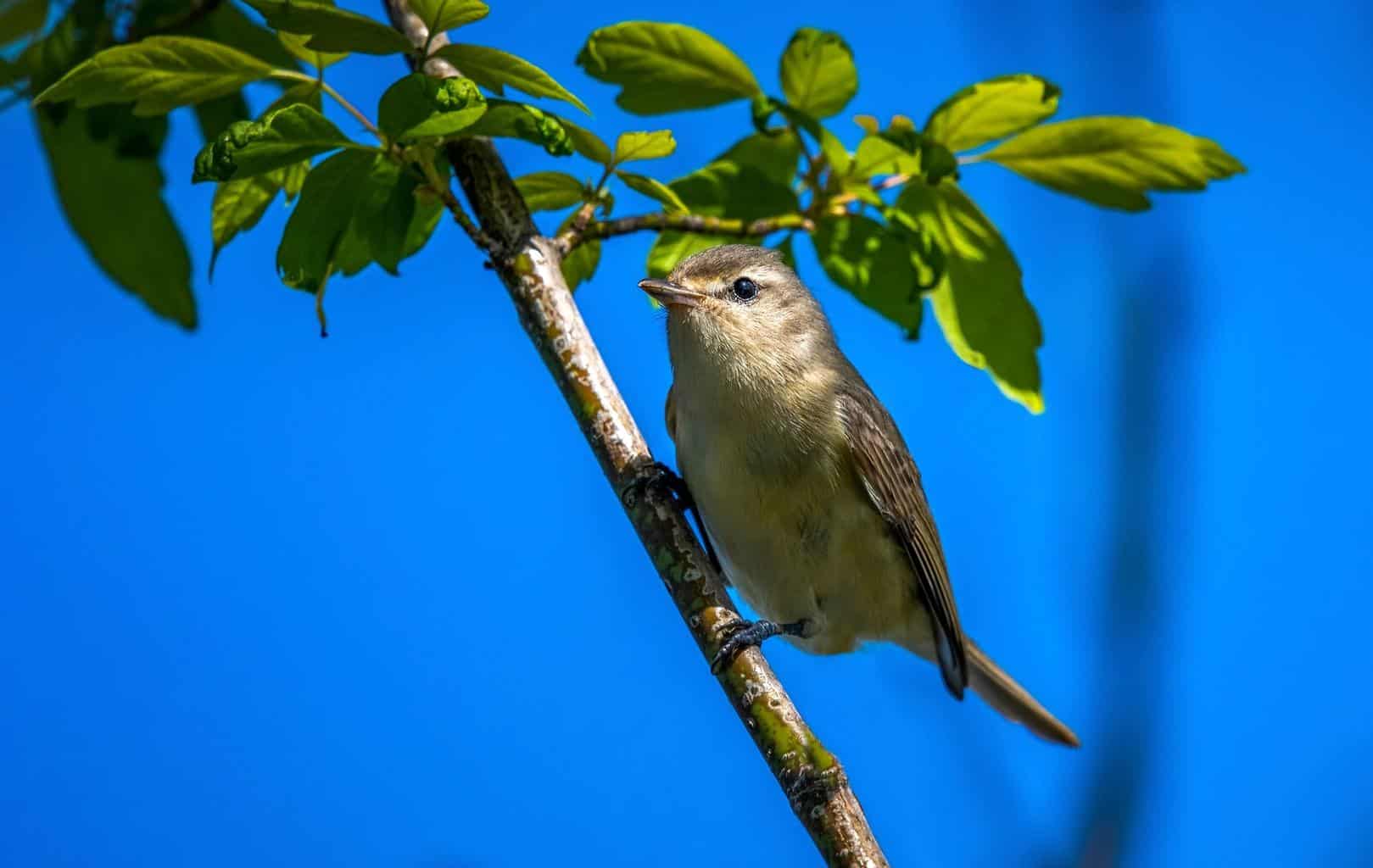
- Scientific Name: Vireo solitarius
- Length: 5-5.8 inches
- Weight: 0.46-0.67 ounces
- Wingspan: 7.9-9.4 inches
The blue-headed vireo is a chunky songbird with an olive-green back, light gray-blue head, medium-length tail, and hooked bill. During the summer, you’ll be able to see this bird foraging in the canopy of mature forests.
This bird frequents the eastern half of North America, including Alabama during the non-breeding season. It’s not a common visitor to backyard feeders and usually feeds on spiders, snails, moths, and butterflies. The bird usually looks for its prey slowly, then flies to catch it.
Eastern Bluebird

- Scientific Name: Sialia sialis
- Length: 6.3-8.3 inches
- Weight: 0.95-1.2 ounces
- Wingspan: 9.8-12.6 inches
The eastern bluebird is a year-round resident of Alabama. The male bird has a vivid deep blue back and head with a rusty chest, while the female bird has a grayish back with blue feathers on the wings and tail.
You can easily spot these swift thrushes perching on telephone wires or flying in open meadows, but they won’t visit your backyard feeder unless you offer mealworms. If you have the space to set up a nesting box, you might be able to attract a breeding pair.
Indigo Bunting
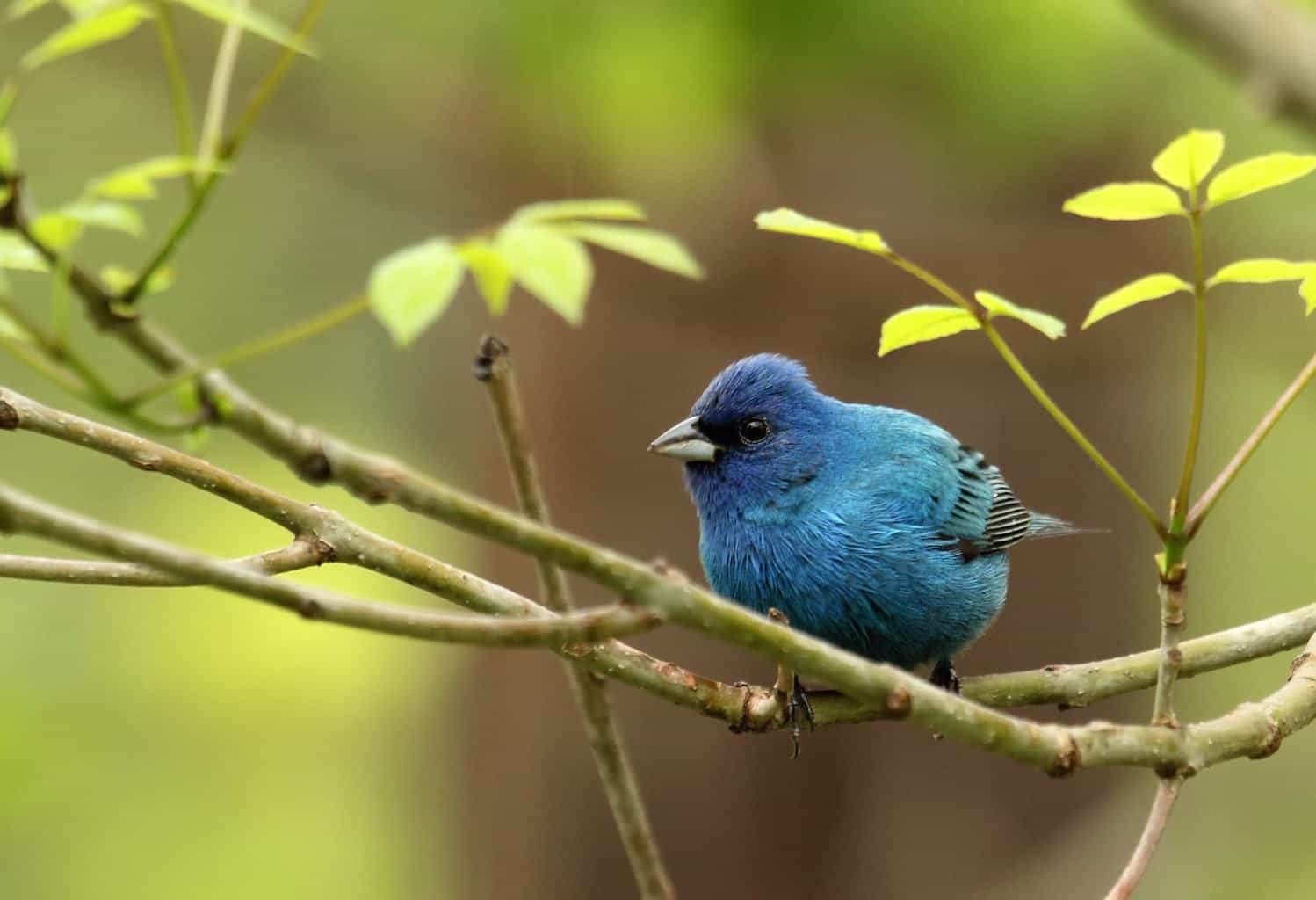
- Scientific Name: Passerina cyanea
- Length: 4.5-5.9 inches
- Weight: about 0.5 ounces
- Wingspan: 7-9 inches
Male indigo buntings are bright blue all over, with a deeper shade of blue on their heads. Female birds are brown with a faint blue marking on the chest and some dark blue plumage towards the wings’ ends.
This small and stocky songbird can be found in Alabama all spring and summer; you’ll hear their singing once they land on phone lines and treetops. It can be found in weedy and brushy areas, as it prefers to hide in woodland edges and overgrown patches.
You can attract the indigo bunting to your backyard feeder by offering small seeds like thistle and live mealworms. During migration, you can see large flocks of this bird feeding in lawns.
Barn Swallow

- Scientific Name: Hirundo rustica
- Length: 6.7-7.5 inches
- Weight: 0.56-0.78 ounces
- Wingspan: 12.6-13.6 inches
The barn swallow is not only common in North America, but in Europe, Asia, Africa, and South America, too. It has a steely blue back, wings, and tail, with a cinnamon-colored forehead and reddish-brown chest. It’s quite common to find the sparrow-sized bird in meadows, fields, farmyards, or perched on telephone wires.
The bird usually feeds on flies, beetles, bees, wasps, and ants and won’t be attracted to suet feeders. However, if you place eggshells on a platform feeder, the barn swallow will certainly be attracted to your backyard. You can also provide a source of mud to encourage a breeding pair to build their nest. A pair of breeding barn swallows will also be attracted to a nesting box, as long as there’s a guard to protect the birds and their eggs from predators.
Green Birds in Alabama
Green Heron
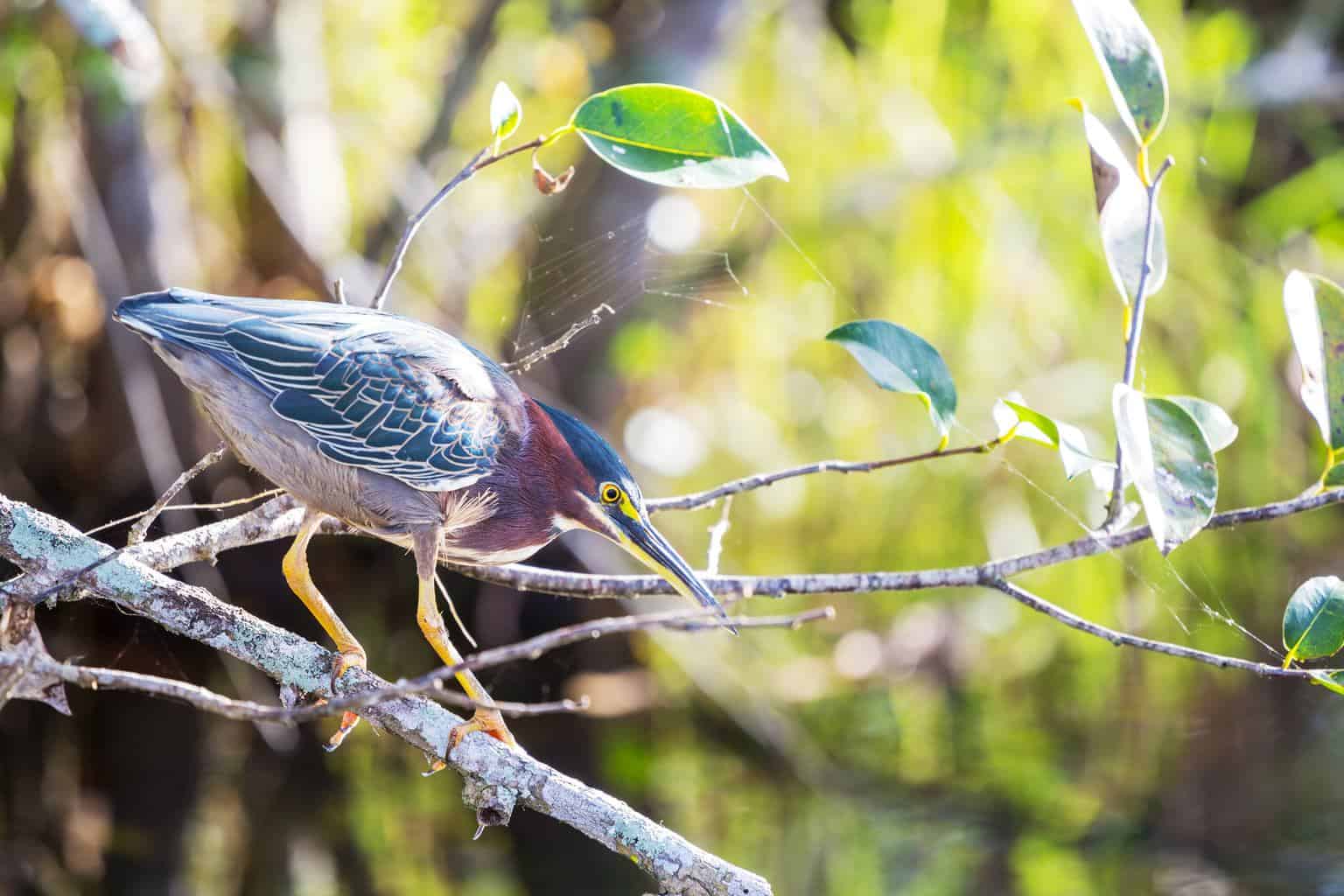
- Scientific Name: Butorides virescens
- Length: 16-18 inches
- Weight: about 8.5 ounces
- Wingspan: 25.2-26.8 inches
The green heron, topped with a short dark crest, is a stocky bird with a velvet-green back, a rich chestnut body, and slender yellow legs. It uses its dagger-like bill to catch fish and amphibians, and it sometimes lures them in with twigs and feathers or insects.
Although this bird is widespread across Alabama and the eastern United States, it’s quite hard to see since it prefers staying concealed at the edges of wetlands. It might, however, visit ornamental fish ponds.
Orange Birds in Alabama
Summer Tanager
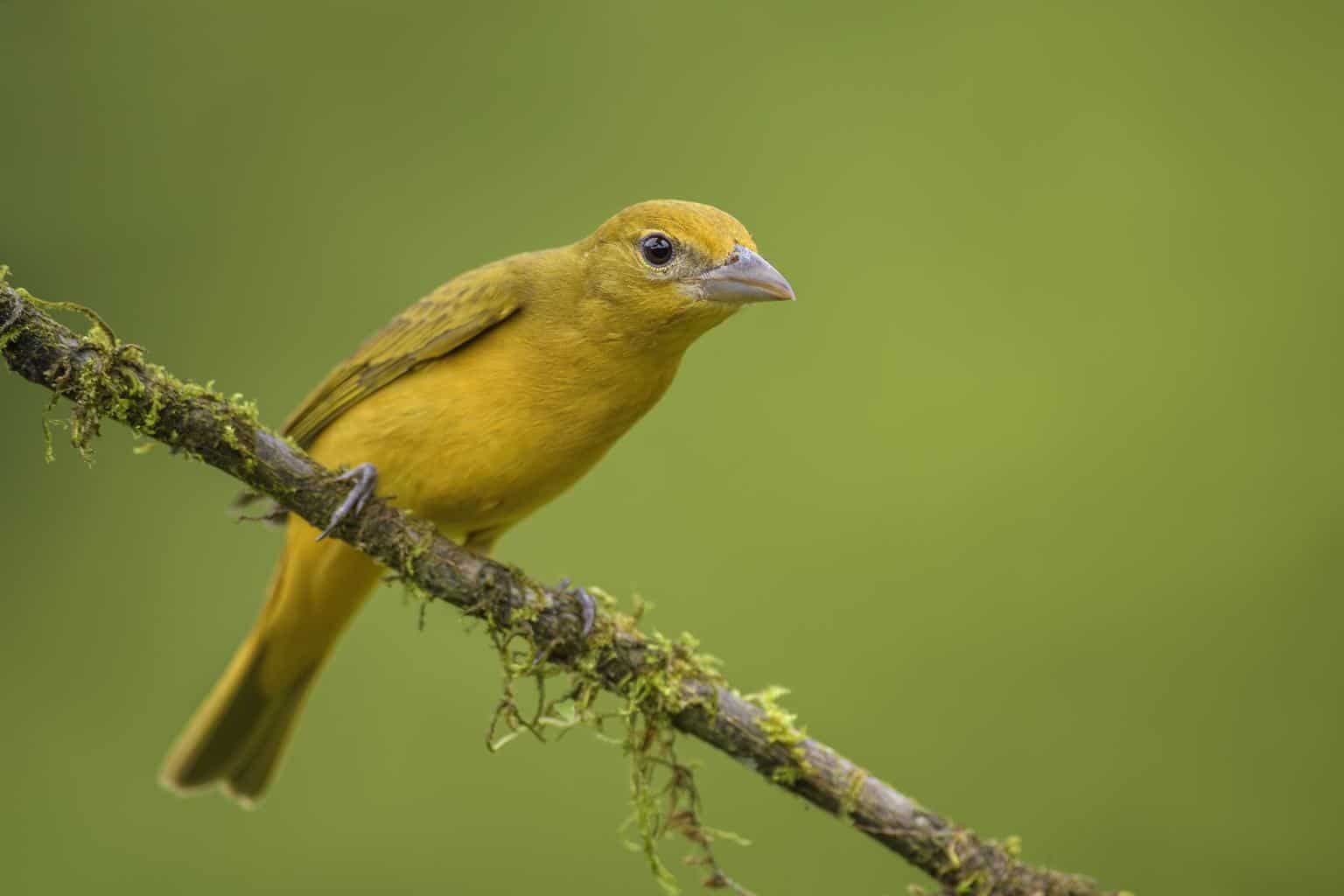
- Scientific Name: Piranga rubra
- Length: about 6.7 inches
- Weight: about 1 ounce
- Wingspan: about 11.8 inches
The summer tanager is a small songbird, and the males are entirely bright red or orange, while the females have bright mustard yellow-green feathers from their heads to the tails. The bird prefers to stay high in the forest canopy and, as its name implies, is quite common in the summer.
This bird prefers to feed on bees and wasps but will occasionally forage at backyard berry bushes, too. The summer tanager has a unique way of catching insects, as it grabs them while they’re flying in the air, then beats them up against a branch. Before eating a bee, this bird will rub it against a branch to get rid of the stinger. It also feeds on grasshoppers, moths, ants, and flies.
Varied Thrush
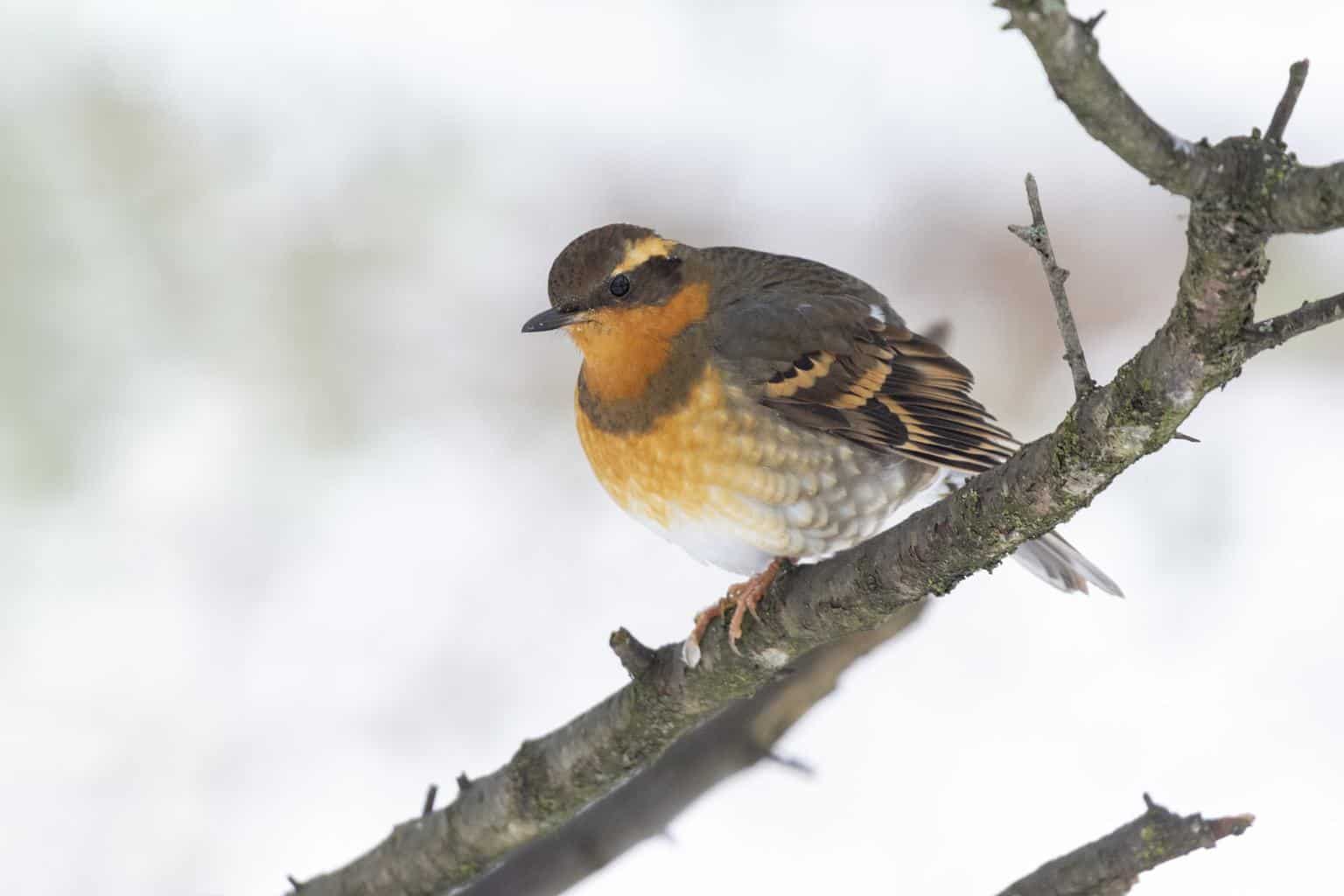
- Scientific Name: Ixoreus naevius
- Length: 7.5-0.2 inches
- Weight: 2.3-3.5 ounces
- Wingspan: 13-15 inches
The male varied thrush has a blue-gray back, an orange belly, and an orange patch above the eyes and towards the ends of the wings, while the female bird has the same pattern but a paler plumage. It looks stocky compared to other songbirds.
You can see this bird hopping on the ground or foraging on low branches, feeding on insects and arthropods in the summer and nuts in fall and winter. The varied thrush will visit your backyard if you have a ground feeder or some fruiting shrubs in your backyard.
Although this bird has a sweet song, it’s quite aggressive and territorial, especially against other types of birds. It’s quite common to see male birds dominating other species at feeders to defend their feeding territories.
Yellow Birds in Alabama
Yellow-Rumped Warbler
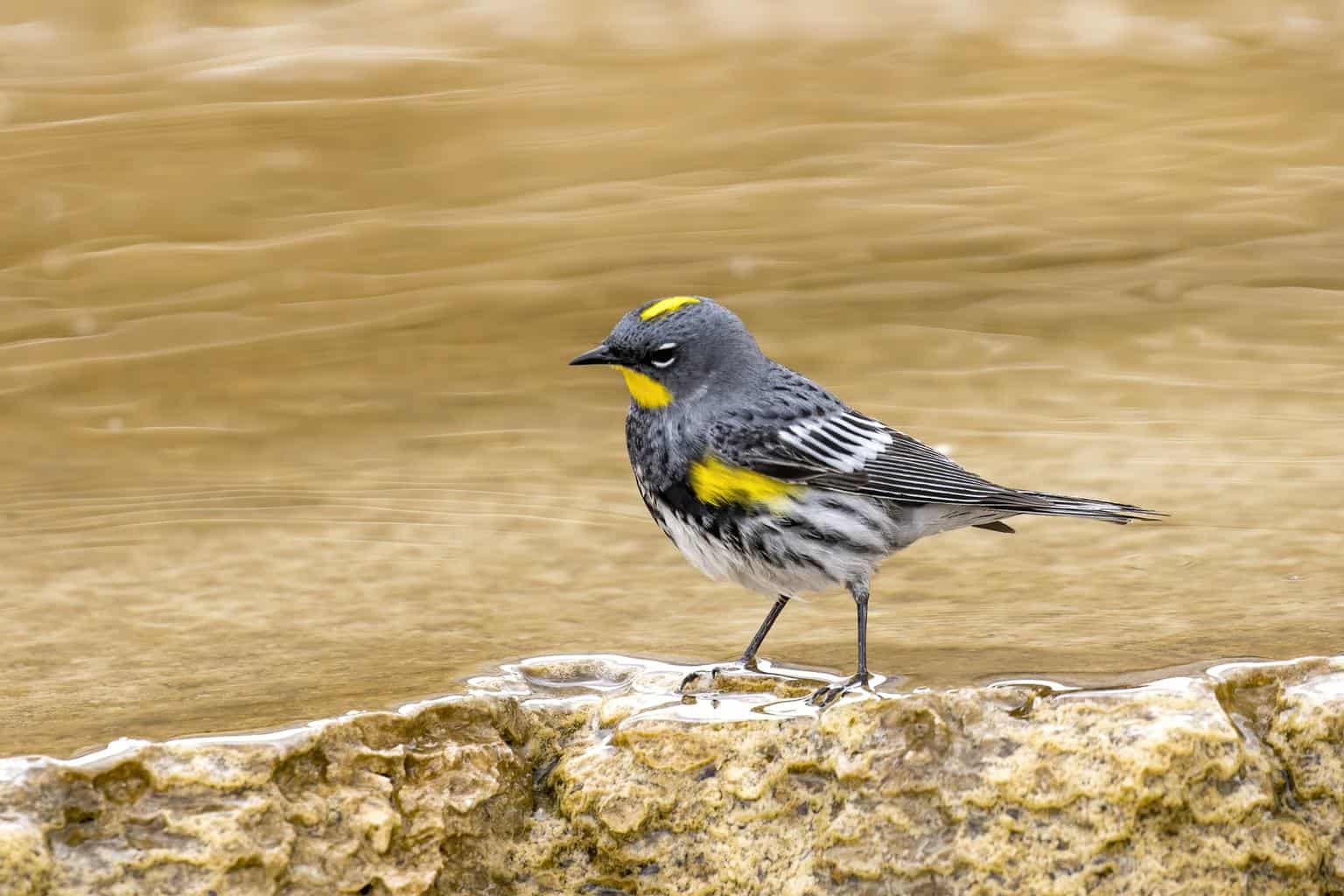
- Scientific Name: Setophaga coronata
- Length: 4.7-5.5 inches
- Weight: 0.4-0.5 ounces
- Wingspan: 7.5-9.1 inches
In the summer, the yellow-rumped warbler is mostly gray with a white wing patch and yellow feathers on its face and sides. In the winter, however, its plumage turns pale brown.
The yellow-rumped warbler perches on trees’ outer limbs in the summer, and if you offer food in the winter, it may visit your backyard. Keep your feeder stocked with suet, peanut butter, and black oil sunflower seeds and you just may be able to snap a few photos of these unique-looking birds as they feed at your home.
American Goldfinch

- Scientific Name: Spinus tristis
- Length: 4.3-5.5 inches
- Weight: 0.39-0.71 ounces
- Wingspan: 7.5-8.7 inches
The American goldfinch has a bright yellow body with a black forehead and wings, but female birds are paler with olive above and yellow underneath. This bird, known for its acrobatic flying style, is easy to find in Alabama.
You can attract this bird to your backyard by setting up any kind of bird feeder and planting thistles. The American goldfinch will also feed on any spilled seeds on the ground, and in the summer, the bird may add insects to its diet.
Yellow-Breasted Chat
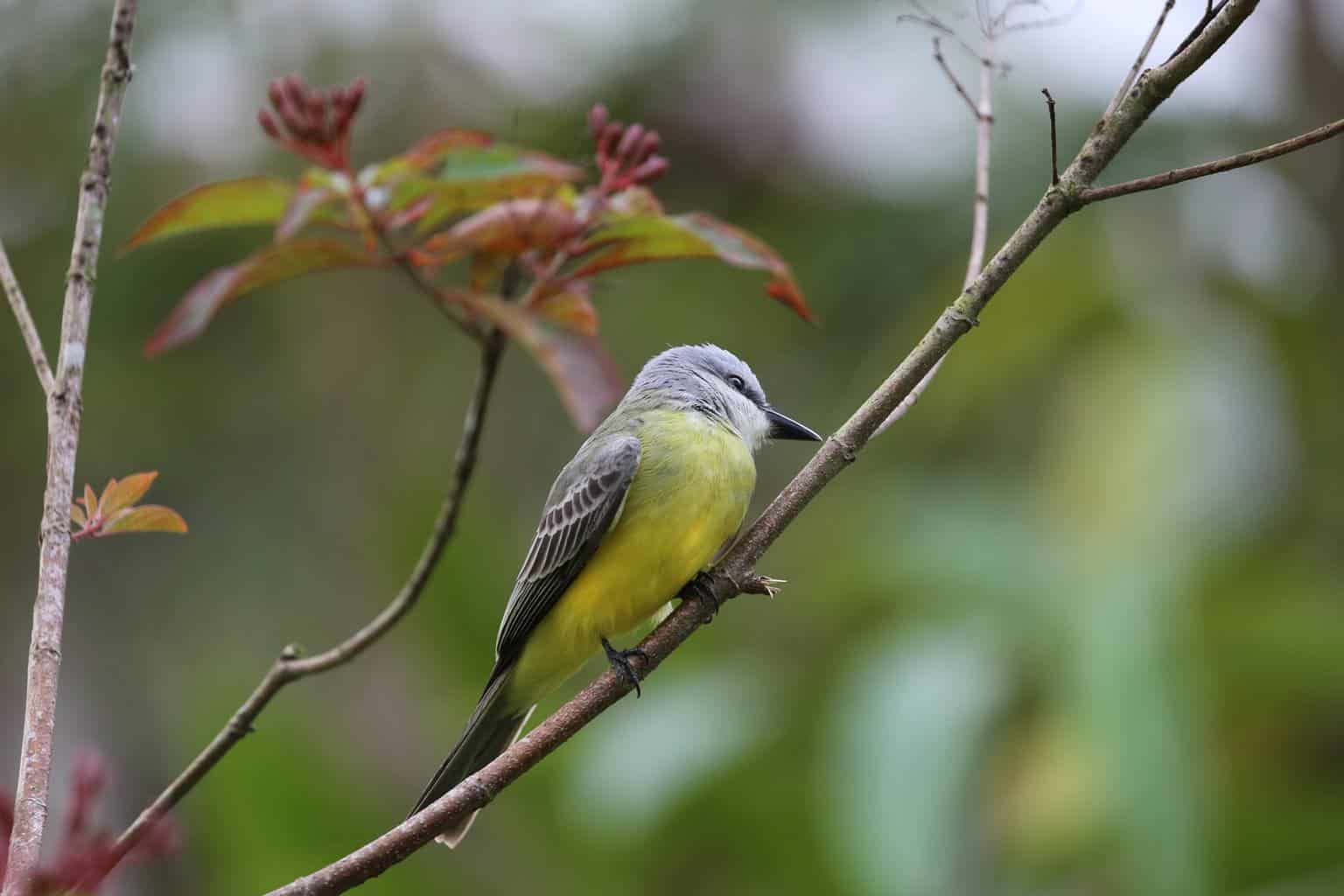
- Scientific Name: Icteria virens
- Length: 6.7-7.5 inches
- Weight: 0.7-1.19 ounces
- Wingspan: 9-10.6 inches
The yellow-breasted chat has an olive-green back with a bright yellow chest and a gray head and face. This is a loud bird that likes to live in the thick bushes; your chances of spotting this bird in Alabama are higher if you find yourself there during the bird’s breeding season.
In the springtime, you’ll find males of this species perched and singing loud songs hoping his calls catch the attention of a female for breeding. Throughout the rest of the year, however, this bird likes to stay well-hidden.
When it’s time for a meal, the bulky warbler forages on spiders, beetles, bugs, cicadas, bees, grasshoppers, and moths. In winter, this bird might feed on berries and fruits.
Other Birds to Watch For in Alabama
American Crow

- Scientific Name: Corvus brachyrhynchos
- Length: 16-21 inches
- Weight: 11-21 ounces
- Wingspan: 33-39 inches
The American crow is not only one of Alabama’s most commonly spotted birds, but one of the most intelligent species, too. It has a wide habitat, ranging from shopping centers to treetops, roadsides, and open woods.
Known for its all-black plumage and short square or rounded tail, the American crow is quite a social bird, often spotted in big flocks scaring away bigger birds of prey, like owls and hawks.
The American crow feeds on anything it can find, including seeds, insects, earthworms, fruit, and sometimes chicks it steals from other birds’ nests. Although the American crow isn’t a regular visitor to backyard feeders, you can attract one by leaving peanuts in an open space.
Bald Eagle

- Scientific Name: Haliaeetus leucocephalus
- Length: 27.9-37.8 inches
- Weight: 6.5-13.5 pounds
- Wingspan: about 6.5 feet
The bald eagle, who has been an emblem for the United States since 1782, is widespread in Alabama and often used as a symbol by the Native American tribes. It can be found close to bodies of water, as it likes to catch fish.
You can easily see this bird in wintertime, where it harasses other birds of prey for their catches.
Bald eagles aren’t actually bald; they have white-feathered heads and a matching tail while the rest of their bodies are dark brown. The birds spend their days soaring high up in the sky until small mammals or a waterfowl catch their attention.
Brown-Headed Cowbird

- Scientific Name: Molothrus ater
- Length: 6.3-8.7 inches
- Weight: 1.1-2.1 ounces
- Wingspan: about 14 inches
You’ll find the brown-headed cowbird with its glossy back and dark brown head in Alabama year-round, likely feeding on the ground with other blackbirds and starlings.
These common birds are quite noisy as they fly about in meadows, pastures, and lawns. Some people consider brown-headed cowbirds to be a nuisance because they destroy other birds’ eggs and feed on small songbird chicks.
As a matter of fact, it’s also a known brood parasite, as females lay eggs in other birds’ nests, where other species care for the eggs and raise the young cowbirds.
Mourning Dove

- Scientific Name: Zenaida macroura
- Length: about 12 inches
- Weight: 4-6 ounces
- Wingspan: about 17.7 inches
The mourning dove has a pale brown to buffy tan plumage with black spots to match its surroundings. This bird is widespread in Alabama, often seen perching on telephone lines or in patches of bare ground.
You can attract this bird to your backyard if you have a platform feeder stocked with millet. You can also plant dense shrubs to provide the birds with a nesting site or set up a nesting cone to attract a breeding pair.
Barred Owl

- Scientific Name: Strix varia
- Length: 16-25 inches
- Weight: 16.6-37 ounces
- Wingspan: 38-49 inches
The barred owl has mottled brown and white overall with barred underparts. During the day, the bird of prey hides quietly in the forest, but when night falls, it hunts small animals and rodents when it will be easier to hear and spot them.
It usually builds its nest in tree cavities, but you can attract a breeding pair to your backyard by setting up a nest box. You can also try to imitate its call and wait until a nearby owl replies.
Cedar Waxwing

- Scientific Name: Bombycilla cedrorum
- Length: 6-7 inches
- Weight: about 1.1 ounces
- Wingspan: 8.7-11.8 inches
The cedar waxwing has brown feathers on its head and chest, gray wings, and pale-yellow belly in addition to bright red wingtips that some birds might lack. This social bird is likely to be seen in large flocks foraging for food in orchards, farms, and suburban gardens.
You can locate this bird if you get yourself familiar with its high-pitched call, and if you plant fruit-bearing bushes and trees, there’s a good chance it will visit your backyard.
Swallow-Tailed Kite

- Scientific Name: Elanoides forficatus
- Length: 20-27 inches
- Weight: 11-21 ounces
- Wingspan: about 48 inches
Swallow-tailed kites are known for their bold white and black plumage and forked tails. They usually chase dragonflies, frogs, lizards, snakes, and even smaller birds from tree branches.
You can spot this bird in the sky, as it might turn its tail and roll itself to catch an insect flying behind it, and it can also be found in wetlands, brackish marshes, and swamps.
Conclusion
There are lots of amazing birds that reside permanently or temporarily in Alabama, making it an exciting spot for birdwatchers and lovers. Just study the area, and you’ll probably see a few of these fantastic creatures flying around or even paying you a visit.

